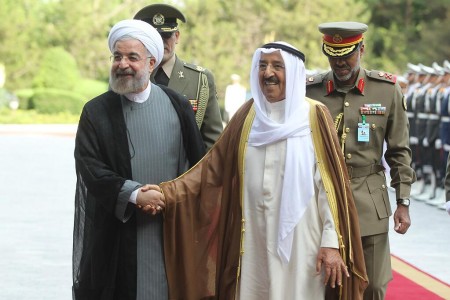President Rouhani (pictured with Emir of Kuwait) stepped up his diplomatic approach of “engagement” last week, with initiatives on the nuclear issue, the Syrian conflict, and other regional issues.
The headline move for Western media was the announcement of the first scheduled bilateral talks between Iran and the US since 1979. The two sides, joined by the European Union, will meet in Geneva on Monday and Tuesday to seek a way forward on a comprehensive nuclear settlement.
The discussions will be followed by the fifth round of negotiations on the comprehensive deal, beginning in Vienna on June 16.
Rouhani’s team were just as active on the Syrian and regional fronts. The President is in Turkey on Monday, hoping to revive economic links amid US-led sanctions and to distance Ankara from its support of Syria’s insurgents.
Tehran also sent a Deputy Foreign Minister to the inauguration of Egyptian President Abdul Fattah El-Sisi, the general who led last July’s coup. While the gesture is not as striking as an appearance by Rouhani — Tehran said that was precluded by the trip to Turkey — it is a marked shift from Iran’s denunciation of the military overthrow of President Mohamed Morsi last summer.
And at the beginning of last week, the Government scored a success for its “engagement” of Gulf States with the visit of the Emir of Kuwait to Tehran. The announcement of economic agreements and shared views on the region was complicated by speculation over the Emir’s confused appearance on his arrival; however, Iran was able to press its attempted rapprochement with Saudi Arabia.
The international maneuvers also took of the heat out of the latest domestic confrontation between Rouhani and his hard-line critics. Tehran Friday Prayer leaders and the President traded barbs over Rouhani’s attempt to ease “heaven’s whip” of social and cultural restrictions. The hardline opposition, Endurance Front, joined in the battle by accusing the Government of appeasing “sedition”.
Economically, the regime still awaited good news. The latest figures on inflation showed a slight increase to more than 30%.
FORECAST
With the Supreme Leader still supporting nuclear talks, President Rouhani is trying to take advantage of the window of opportunity. The discussions with the US and European Union, followed by the high-level negotiations in Vienna, are seeking the victory of a comprehensive accord.
That victory would not only be on the immediate ground of the nuclear issue. It would give Rouhani leverage in his domestic battle with hardliners on the political and cultural fronts.
That leverage is unlikely to bring significant Government moves — after all, the Supreme Leader is showing resolute opposition to any easing of the environment. However, if Rouhani can follow up the nuclear advance with an upturn for Iran’s economy, it could secure his footing for the medium-term.
The likely complication is that there will be no nuclear resolution by July 20. In that case, the Government will have to play for time by extending an interim Joint Plan of Agreement and continuing negotiations through the summer and autumn.
The high-profile “engagement” on regional issues is also not going to be straightforward. Saudi Arabia continues to show caution over Iran’s approaches, and Tehran’s PR offensive for a political resolution in Syria is unlikely to bring an immediate shift in Turkey’s position on the insurgency — at least not while the Saudis continue to back opposition to Assad and the US is still not convinced of the Syrian regime’s legitimacy.
So the nuclear and regional “engagement” go hand-in-hand. Any advance on one front opens up possibilities on the other; however, any setback disrupts Rouhani’s strategy.
And any setback could also leave the President vulnerable to the pressure at home.
FEATURED ANALYSES
A Beginner’s Guide to Uranium Issue in Nuclear Talks
How Europe Can Help Complete A Nuclear Deal
Supreme Leader Uses Khomeini Memorial to Denounce US & Its “Global Arrogance”
An Ahmadinejad Comeback?
FEATURED 1ST-HAND
How Regime Smeared Founder of “Stealthy Freedom” Hijab Campaign

